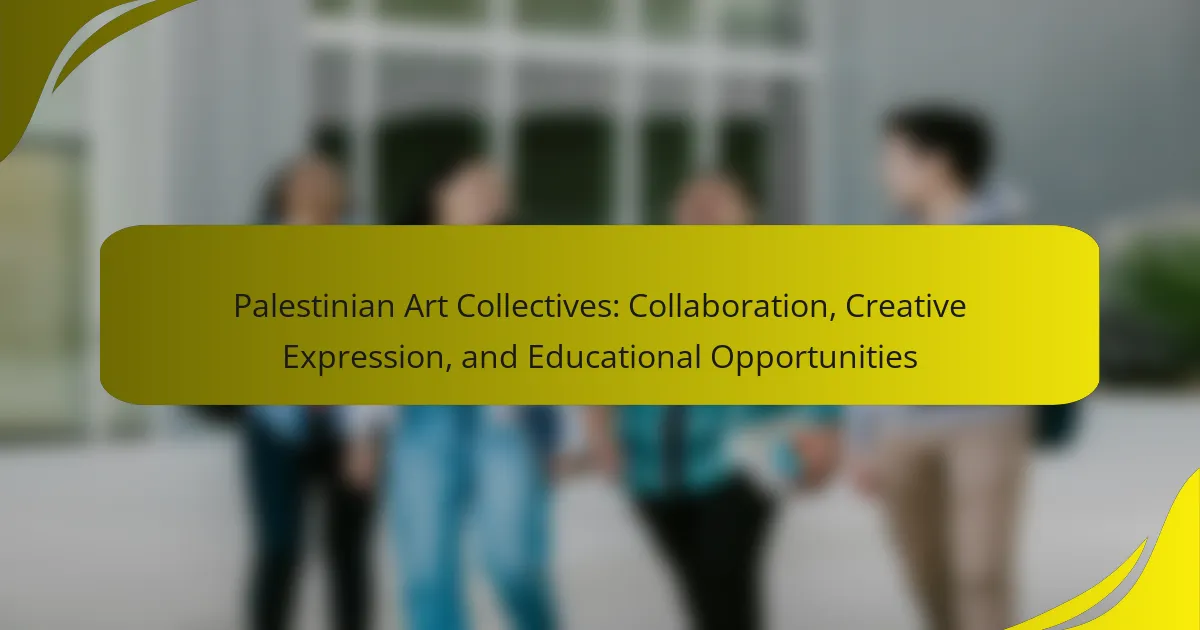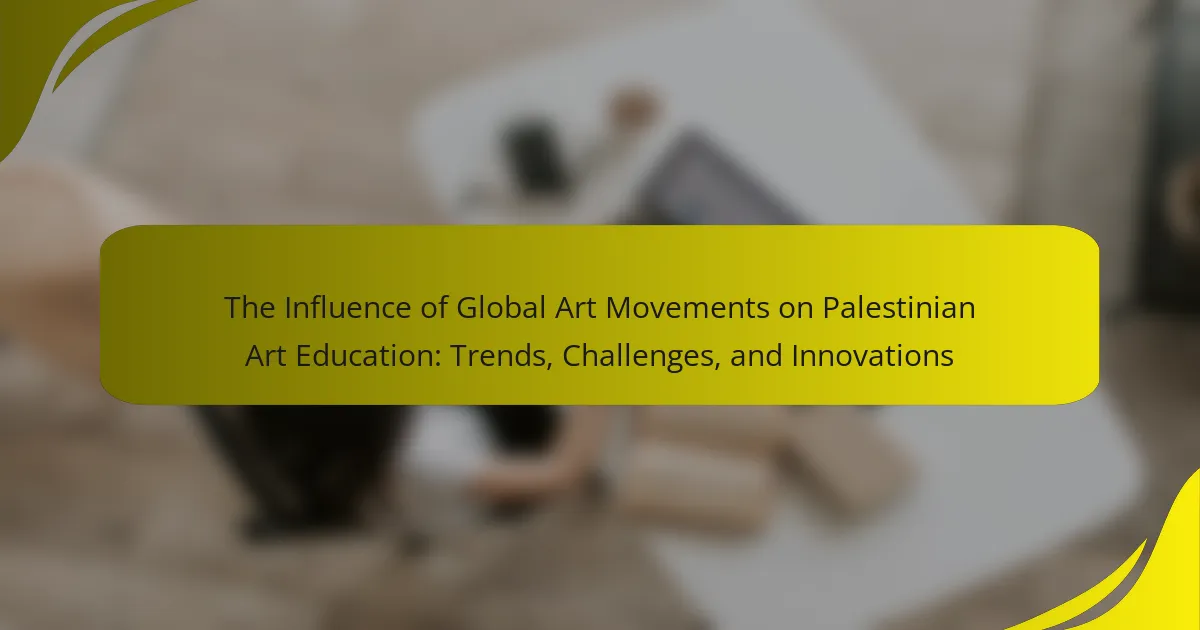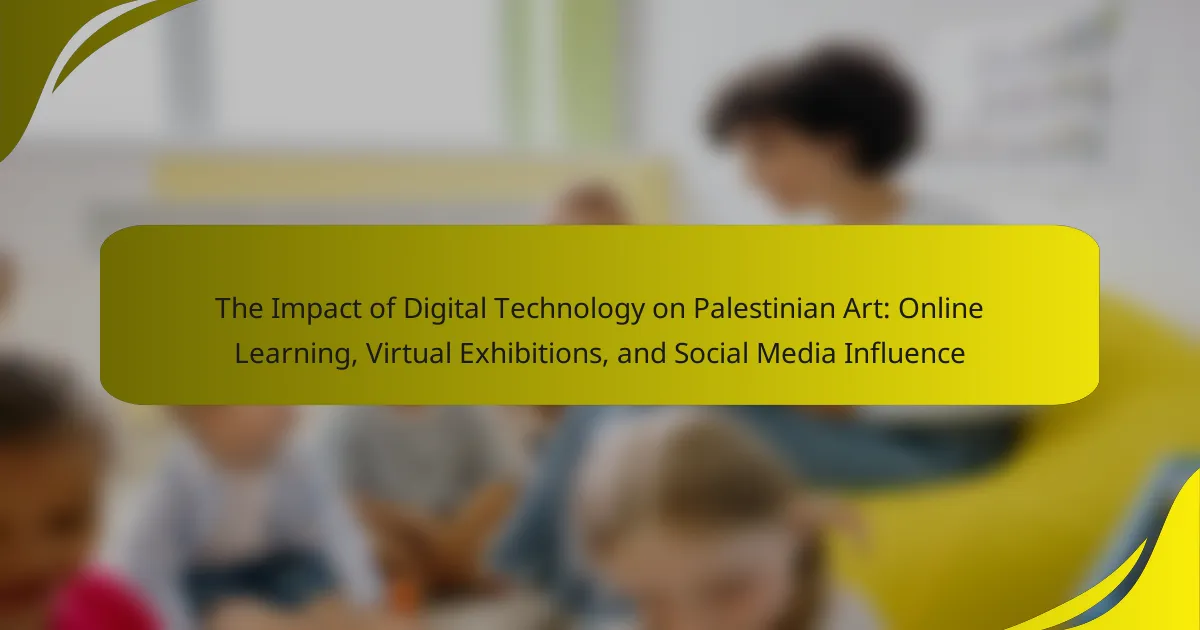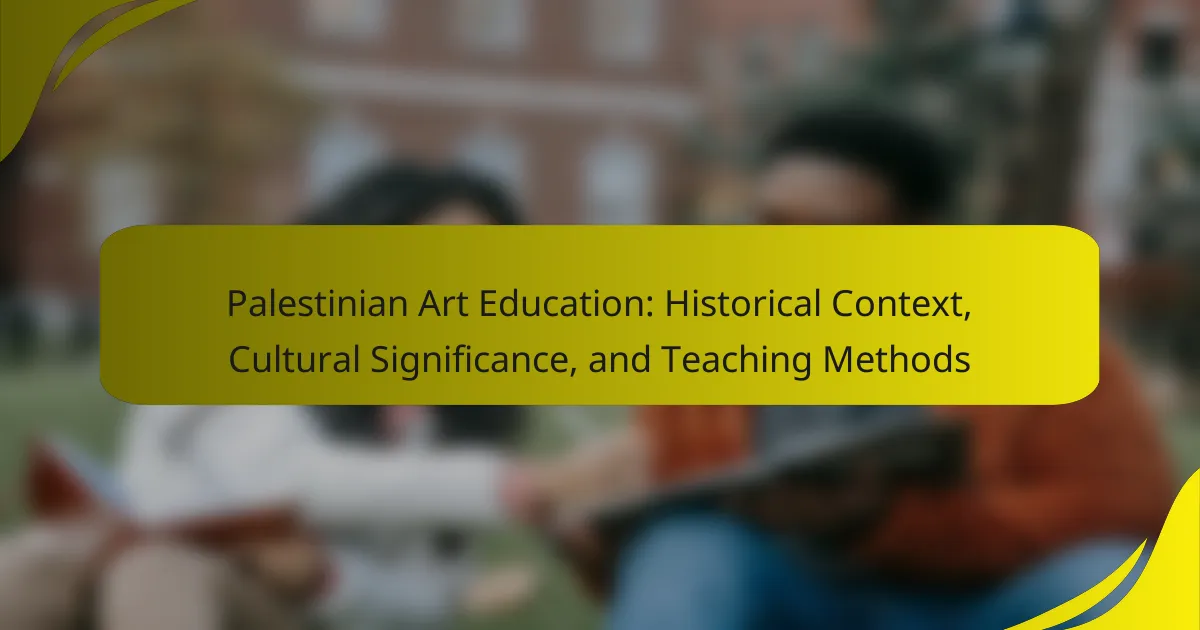Women’s contribution to Palestinian art plays a crucial role in cultural representation and empowerment. Palestinian women artists utilize various artistic forms to express their unique experiences, addressing themes of identity, resistance, and social issues. Notable artists such as Mona Hatoum and Emily Jacir have gained international recognition, emphasizing the importance of women’s narratives in a male-dominated field. Educational initiatives, including programs and workshops, aim to empower female artists through skill development and mentorship, fostering a supportive environment for showcasing their work. Targeted funding, resources, and community art projects further enhance the visibility of women’s contributions, preserving their legacy and inspiring future generations.
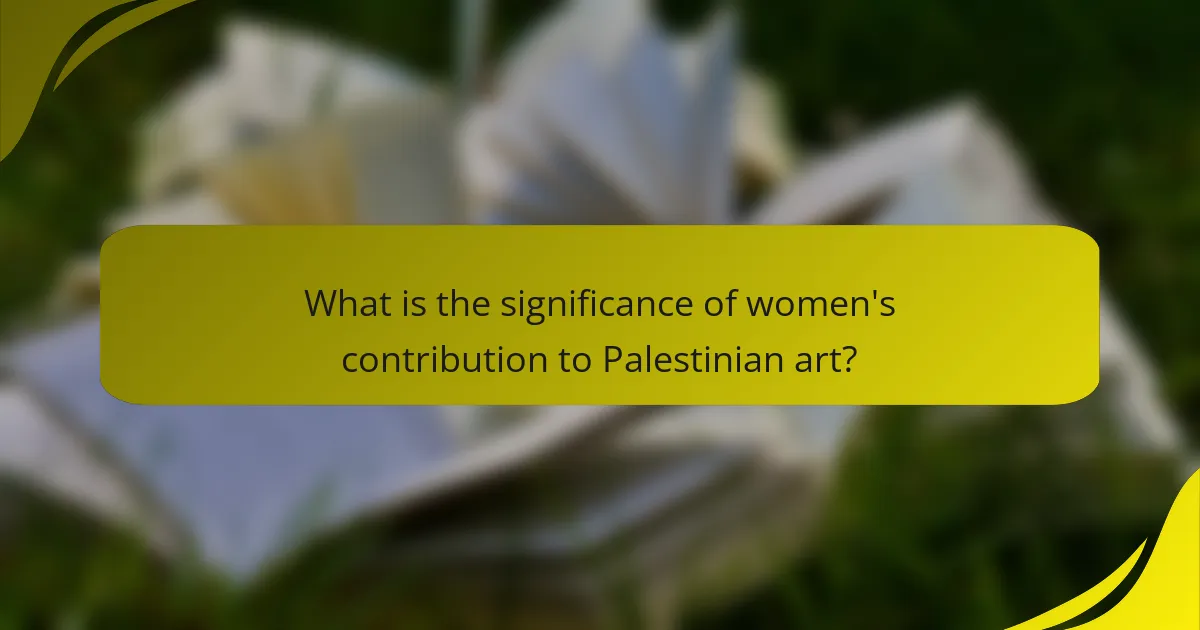
What is the significance of women’s contribution to Palestinian art?
Women’s contribution to Palestinian art is significant for its role in cultural representation and empowerment. Palestinian women artists express their experiences and perspectives through various artistic forms. Their work often addresses themes of identity, resistance, and social issues. This contribution challenges traditional gender roles and promotes visibility for women’s voices in a predominantly male-dominated field. Notably, artists like Mona Hatoum and Emily Jacir have gained international recognition, highlighting the importance of women’s narratives. Furthermore, initiatives supporting women’s art education foster skills and opportunities for future generations. This ongoing engagement enriches Palestinian cultural heritage and promotes social change.
How has women’s representation evolved in Palestinian art?
Women’s representation in Palestinian art has evolved significantly over the past few decades. Initially, women’s roles were often marginalized within the artistic community. However, the rise of feminist movements and increased awareness of gender issues have led to greater visibility for female artists. Contemporary Palestinian women artists now tackle themes of identity, resistance, and social justice in their work. Their contributions have been recognized in both local and international exhibitions. The establishment of art collectives and educational initiatives has also empowered women in the arts. Notable artists like Emily Jacir and Mona Hatoum have gained international acclaim, showcasing the depth of women’s perspectives. This evolution reflects broader societal changes and the ongoing struggle for gender equality in Palestine.
What historical factors influenced women’s roles in Palestinian art?
Historical factors influencing women’s roles in Palestinian art include socio-political changes and cultural shifts. The Israeli-Palestinian conflict has significantly shaped artistic expression. Women began to use art as a means of resistance and identity. The feminist movement in the 1970s encouraged women’s participation in the arts. Educational initiatives provided women with access to artistic training. Traditional gender roles were challenged as women gained visibility in public spaces. The rise of Palestinian nationalism also inspired female artists to depict their experiences. These factors collectively enhanced the representation of women in Palestinian art.
How do contemporary women artists express their identity through art?
Contemporary women artists express their identity through art by exploring themes of culture, gender, and social justice. They often incorporate personal narratives into their work. This approach reflects their unique experiences and perspectives. Many use traditional Palestinian symbols and motifs to connect with their heritage. Their art challenges stereotypes and advocates for women’s rights. For example, artists like Shadia Marhaban utilize mixed media to convey complex identities. Others, such as Abeer Seikaly, address issues of displacement and belonging in their installations. This artistic expression fosters dialogue and raises awareness about women’s roles in society.
Why is empowerment crucial for women in the Palestinian art scene?
Empowerment is crucial for women in the Palestinian art scene because it fosters self-expression and creativity. Women artists often face societal and cultural barriers. Empowerment helps them overcome these obstacles. It allows them to share their perspectives and narratives. This representation is vital for cultural identity. Studies show that empowered women contribute significantly to community resilience. Their art can challenge stereotypes and promote social change. Additionally, empowerment provides access to resources and networks. This support enhances their visibility in the art world.
What initiatives promote the empowerment of women artists in Palestine?
Initiatives that promote the empowerment of women artists in Palestine include various programs and organizations focused on artistic development. One significant initiative is the “Palestinian Women’s Art Forum,” which provides a platform for women artists to showcase their work. This forum also offers workshops and mentorship programs to enhance skills and visibility. Another key initiative is “Al-Quds University’s Art Program,” which incorporates female artists into its curriculum and promotes their contributions. Additionally, “The Khalil Sakakini Cultural Center” hosts exhibitions and events specifically highlighting women artists. These initiatives collectively aim to foster a supportive environment for women in the arts, addressing cultural and social barriers they face.
How do these initiatives impact the broader community?
These initiatives enhance the broader community by fostering cultural expression and empowerment. They provide women with platforms to showcase their artistic talents. This representation challenges stereotypes and promotes gender equality. Educational programs increase access to art education for women and girls. Increased participation in the arts leads to community cohesion and dialogue. Research indicates that such initiatives can boost local economies through cultural tourism. They also contribute to preserving Palestinian heritage and identity. Overall, these initiatives create a more inclusive and vibrant community.
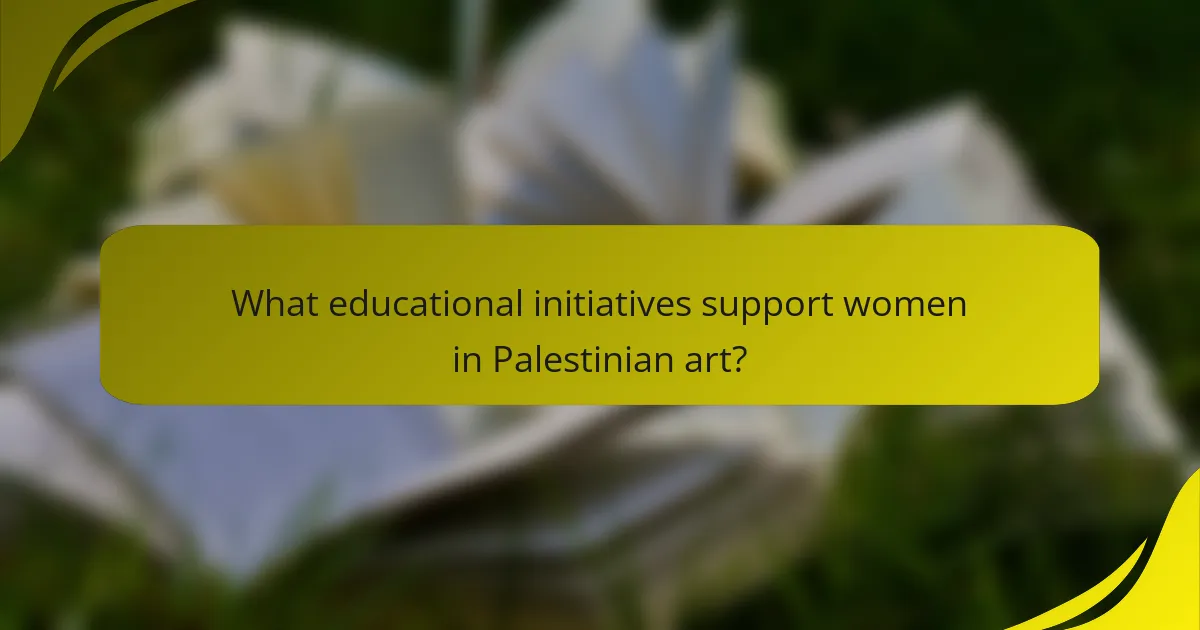
What educational initiatives support women in Palestinian art?
Educational initiatives supporting women in Palestinian art include various programs and workshops. These initiatives aim to empower female artists through skill development and mentorship. Organizations like the Khalil Sakakini Cultural Center offer art classes specifically for women. The Al-Quds University also has programs that focus on women’s contributions to art. Additionally, community art projects provide platforms for women to showcase their work. These initiatives help raise awareness of women’s issues in the Palestinian context. They foster a supportive environment for female artists to thrive. Overall, these educational efforts contribute significantly to the representation of women in Palestinian art.
How do art education programs specifically cater to women?
Art education programs specifically cater to women by creating inclusive environments that address their unique experiences. These programs often provide female-focused workshops and mentorship opportunities. They emphasize female artists’ contributions and perspectives in the curriculum. Many programs also offer scholarships specifically for women to encourage participation. Research shows that women benefit from networking opportunities within these programs. Some initiatives focus on empowering women through art as a form of expression. Additionally, art education programs may collaborate with local women’s organizations to enhance outreach. This targeted approach fosters a supportive community for women artists.
What are the key components of successful art education for women?
Key components of successful art education for women include access to resources, mentorship, and community support. Access to resources ensures that women have the materials and facilities needed for artistic expression. Mentorship from experienced artists fosters skill development and confidence. Community support creates a network that encourages collaboration and sharing of experiences. Research indicates that programs integrating these components lead to increased participation and success among women in the arts. For instance, a study by the National Endowment for the Arts found that mentorship programs significantly improve retention rates in artistic fields for women.
How do mentorship opportunities enhance women’s artistic development?
Mentorship opportunities enhance women’s artistic development by providing guidance, support, and networking. These programs connect emerging female artists with established professionals. This relationship fosters skill development and boosts confidence. Mentorship also offers access to resources and feedback that are crucial for growth. Research indicates that women in creative fields benefit significantly from mentorship. A study by the National Endowment for the Arts shows that mentorship leads to increased visibility and opportunities for women artists. Furthermore, mentorship helps create a supportive community that encourages collaboration and innovation. This environment is essential for nurturing talent and promoting artistic expression among women.
What role do cultural institutions play in supporting women artists?
Cultural institutions play a crucial role in supporting women artists by providing platforms for visibility and recognition. They organize exhibitions that specifically feature female artists, showcasing their work to broader audiences. These institutions often offer grants and funding opportunities aimed at women artists, helping to alleviate financial barriers. Additionally, they provide educational programs and workshops that empower women through skill development and networking. Research indicates that institutions that prioritize diversity in programming enhance the representation of women in the arts. For example, the National Museum of Women in the Arts in Washington, D.C. focuses exclusively on women artists, influencing other institutions to follow suit. By fostering an inclusive environment, cultural institutions contribute significantly to the advancement of women in the art world.
How do galleries and museums showcase women’s contributions to art?
Galleries and museums showcase women’s contributions to art through dedicated exhibitions and collections. These institutions highlight female artists’ works, emphasizing their historical and contemporary significance. For example, many galleries curate shows focused solely on women artists. They often include educational programs that discuss women’s roles in art history. Additionally, museums may collaborate with female artists for special projects. They also provide platforms for underrepresented voices in the art community. Such initiatives help raise awareness of gender disparities in the art world. Overall, these efforts contribute to a more inclusive representation of women’s artistic achievements.
What collaborations exist between institutions and women artists?
Collaborations between institutions and women artists include various partnerships aimed at promoting art and cultural representation. Institutions like galleries and museums often host exhibitions featuring women artists. These collaborations can involve joint projects, workshops, and educational programs. For example, the Palestinian Museum collaborates with women artists to showcase their work and narratives. Similarly, universities may partner with local female artists for art programs or community outreach. These initiatives help elevate the visibility of women’s contributions to art. They also foster empowerment through creative expression.

How can we further support women’s contributions to Palestinian art?
Supporting women’s contributions to Palestinian art can be achieved through targeted funding and resources. Grants specifically for women artists can help them create and showcase their work. Establishing mentorship programs connects emerging female artists with established figures in the art community. Promoting exhibitions that focus on women’s art highlights their contributions and raises awareness. Collaborating with local and international organizations can amplify their voices and reach wider audiences. Providing educational workshops empowers women with skills and knowledge in various artistic disciplines. Investing in community art projects encourages participation and fosters a supportive network. Documenting and archiving women’s art history preserves their legacy and inspires future generations.
What best practices can be implemented to enhance support for women artists?
Implementing mentorship programs for women artists enhances their support significantly. These programs connect emerging artists with established professionals. They provide guidance, networking opportunities, and skill development. Research shows that mentorship increases confidence and career advancement for women in the arts.
Additionally, creating funding opportunities specifically for women artists is crucial. Grants and scholarships can alleviate financial barriers. Statistics indicate that women artists often have less access to funding compared to their male counterparts.
Hosting exhibitions that focus on women artists also promotes visibility. These events can showcase their work and attract wider audiences. Studies reveal that representation in galleries can lead to increased sales and recognition for women artists.
Collaborating with organizations dedicated to women’s rights can amplify efforts. Partnerships can lead to more resources and support networks. Evidence suggests that collective initiatives often yield better outcomes for marginalized groups.
Lastly, incorporating women’s art history into educational curricula fosters appreciation. Teaching about women artists can inspire future generations. Research highlights that early exposure to diverse artists encourages inclusivity in the art community.
How can community engagement strengthen the visibility of women in art?
Community engagement can strengthen the visibility of women in art by fostering inclusive platforms for their work. Local events, workshops, and exhibitions can highlight female artists and their contributions. Engaging the community creates a supportive network that amplifies women’s voices. Collaborative projects can showcase diverse artistic expressions and narratives. Research shows that visibility increases when women artists are featured in community-driven initiatives. For instance, programs like “Women in the Arts” have successfully elevated female representation in local galleries. This engagement not only empowers women but also educates the community about their artistic significance. Thus, community involvement is essential for enhancing the recognition of women in the art world.
What resources are available for aspiring women artists in Palestine?
Aspiring women artists in Palestine have access to various resources. These include art workshops and training programs offered by local organizations. Initiatives like the Palestinian Art Court provide mentorship and exhibition opportunities. Additionally, cultural centers such as the Khalil Sakakini Cultural Center support women artists through events and networking. Grants and funding from international bodies are also available to support their projects. Organizations like Al-Ma’mal Foundation offer residency programs for emerging artists. Furthermore, online platforms and social media facilitate connections and visibility for their work.
Women’s contribution to Palestinian art is a significant aspect of cultural representation and empowerment, with female artists expressing their experiences through various artistic forms. The article explores the evolution of women’s representation in Palestinian art, influenced by historical factors and contemporary themes of identity and resistance. It highlights the importance of empowerment initiatives and educational programs that support women artists, fostering skills and visibility in a predominantly male-dominated field. Additionally, it examines the role of cultural institutions in promoting women’s contributions and the impact of community engagement on enhancing their visibility in the art world.
